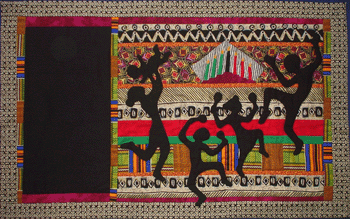| Creating the Kwanzaa Quilt Since the colors of Kwanzaa are red, green and black I wanted use predominantly those colors in this quilt. I wanted to include the candles, of course. Other possible subjects included corn, fruits and vegetables, the traditional straw mat, and the unity cup. Considering African art, I thought I should try for a design with geometric, hard-edged, rhythmic, angular patterns. Definitely happy and upbeat. When taking an alternate route home from a visit to the Bay Area I looked up to see a large Hancocks Fabric Store. Even though I was already running a bit late I couldn't resist stopping. I was working on the Nian quilt at the time and had been looking for something with a Chinese feel for the border. I did not find that, but did find a display of African fabrics. How lucky! |
Other than the fabrics
all images and text © Anna Grossnickle Hines 2005
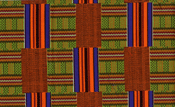 |
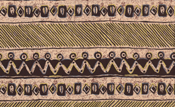 |
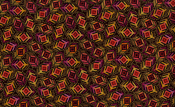 |
 |
|
Those fabrics changed my thinking about the quilt. Cutting them into tiny pieces would destroy the patterns in these fabrics. I needed to think larger pieces. Also, my editor had suggested that I try to get more people into the quilts. This might be a good opportunity to do that. I scanned the fabrics and played with their placement as a background. Then I began sketching dancing figures; a family since Kwanzaa is a family centered holiday. |
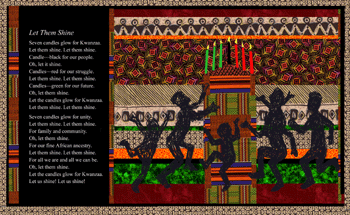
|
I needed to leave a plain space for the poem, and I didn't want to keep all the joy of the dancers onto just one page. This made it a little difficult to make things balance and not let anything get lost in the gutter (where the book folds). |

|
After trying the figures in a line I chose to let them float more freely. In this design the gutter will fall between the mother and baby and the boy. This poem is not the same as the one that ended up in the book. It was particularly challenging to write a poem about holiday with which I've had no personal experience. I hope I've captured a bit of the flavor and feel of the holiday. |

|
I traced the lines of my pattern onto the back of a pieces of muslin. I sewed the large band of horizontal stripes on using the foundation piecing technique; placing the fabric on the front side, sewing along the line on the back, pressing the seam open, then placing the next strip right sides together with the last and again stitching along the line on the back. I sewed the red ends on the large black vertical piece and sewed it and the other vertical pieces on in the same manner. |

|
I traced my dancing figures onto freezer paper, cut them out, pressed them onto my black fabric and cut them out. Using the method I developed for WHISTLING I followed the lines I'd drawn on the muslin to run a basting stitch around the figures. I used these stitches as a guide to appliqué the figures onto the front of the quilt. This photo shows several paper patterns on the black fabric and one, on which I am in the process of turning the edges under, lying the back of the quilt. |
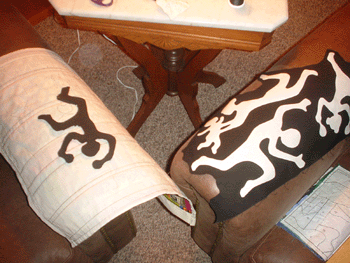
|
I also appliquéd the candles and kinara onto the quilt. At this point, it was finished by I was troubled that the candles didn't seem to show up well. As part of the design that didn't matter, but since they are key to the theme of the book, it did. Choosing a color to put behind them was a problem because it couldn't be red, green, yellow or black--all the colors of the quilt! |

|
I ended up putting a piece of the striped section of the black and cream fabric behind the candles. It does help the candles show up. Shout Harambee! (a Kwanzaa poem) |
